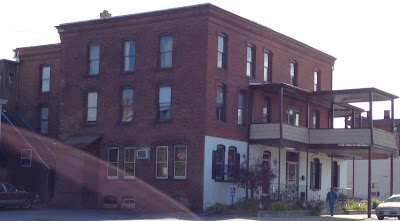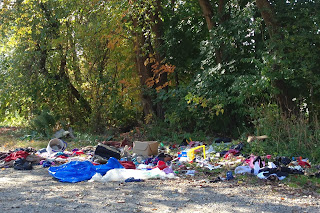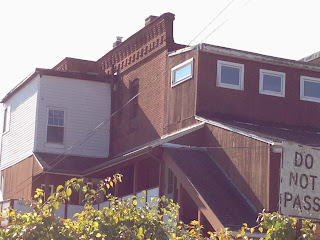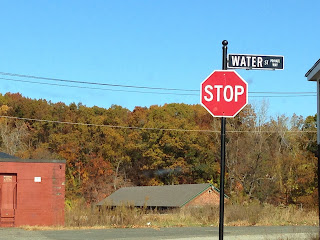Indian Orchard for a town name. Geez doesn't that say something? Well, first off, it really isn't a town, but more like a section of the larger metropolitan area of Springfield, MA. But it does have it's own zip code and downtown with a main street. It did have an industrial center and mill industry along the Chicopee River and rail trail line. Of course the pathways that led to roadways and some of the extant town and street names speaks to the Indigenous Folks that just so happened to exist here before the invasion. Springfield natives were "Agawams", a
group centered in present Springfield and West Springfield. Regionally,
the Agawams were probably affiliated with the Pocumtucks, the dominant native group in the westernmost portion of Massachusetts in the early 17th century.
Secondary village centers formed around industrial mill sites at Indian Orchard (Chicopee River) during the War of 1812. Next came the steam railroad which opened up the growth of industry. Major north-south routes from Hartford and Northampton were located along east bank meadows in 1844-45 as the Connecticut River Railroad with the Union Depot, opened in 1851 as the junction with the Boston & Albany. A branch line to Indian Orchard mills from the B & A opened in 1849 with location along Pinevale Street still in place (abandoned).
The mill village at Indian Orchard came alive after the rail system. The Indian Orchard Canal Company was incorporated in 1839, but it was apparently not until 1853, after the incorporation of Chicopee, that mills were established on the power canal built there. In that year, the Ward Manufacturing Company started the manufacture of cotton cloth, a company reorganized in 1859 as the Indian Orchard Mills. Interestingly enough, as the mills grew along with population, by the late 1800's there was an influx of French Canadian migrants to work the mills at Indian Orchard.
The Indian Orchard Mills are utilitarian multi-story brick Romanesque Revival structures of extended length. They also incorporate mansard roofs. At Indian Orchard, both Chapman Valve and the Indian Orchard Mfg.Co. have major Late Industrial period complexes. The Indian Orchard Mills are now a mixed re-use complex of artists + small industries w/ 300,000 sq. ft.
 |
| We visited 2-3 bldgs. thru these annex walkways |
 |
| There were 13 bldgs. in the complex and this is one of them. |
 |
| We came for the open studios in the Spring of 2011 |

 |
 |
| The remains a few months later |
The Mills may have gone, but the village is still there. A quiet enclave of former mill housing survives and surrounds the once mighty mills.
 |
| One of the churches is viewable in the background. |
 |
| Hidden in this odd little back area behind Main St. + before the water is the famous Titanic Museum, but it wasn't open. I was bummed. Another day. |

This is the terminus of the street that another huge industrial complex once existed on and where the rail road came.
Center St. runs behind Main St. + before Water. A lot of the back side of Main st. homes were captured to show how they willy-nilly added on to grow the bldgs.
 |
| A classic tenement house. I wonder who lived there then + who lives there now. |
 |
About National House
Neighborhood bar with pool tables, games, and keno. Plenty of parking. Weekly room rentals.
|
 |
| This hotel at 13 Oak St. is owned by Sharon Mikaelian. The bar seemed to be already open on a Tues. morn + folks were wandering about. I'd sure like to know more of the history of this place! |
Rail service began in the mid 1800's. The junction
with the Boston & Albany had a branch line to Indian Orchard mills
from the B & A which opened in 1849 with location along Pinevale Street
still in place (abandoned). Pieces of this rail line are extant in places along the water and front streets.

Rails ran right up to the buildings.

Later came the docks where large semi's could back up to.
The HeatBath Corp. appears to own a few bldgs. down here. This loading dock is but one site. Heatbath Corporation is proud to be celebrating 90 years of service to the metal finishing and heat treating industries. They have been here since 1923 and are Metal Finishing Experts.
Water St. has a whole line of Mill housing. A quiet one way street that dead ends.
 |
| Classic Mill housing w/ the side-by-side or mirror houses, which we now call duplexes. |
 |
| The end of Water Street. Not sure what the business was, but now just an overgrown abandoned property. |
 |
| The colorful dumping ground at the end of Water St. in Indian Orchard, MA |

































I live in Indian Orchard. It's pretty cool to learn about the history of where I live.
ReplyDelete